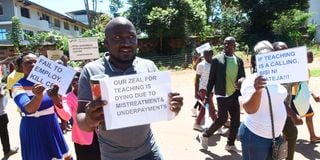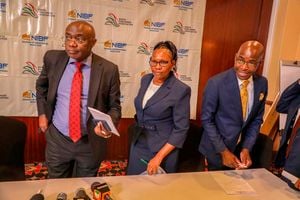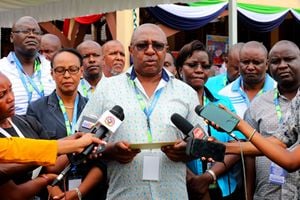
Junior Secondary School teachers during a past protest in Kakamega town to demand better terms of employment for interns.
The government is racing against time to get infrastructure in place ahead of January 2025 when the pioneer class of the competency-based curriculum (CBC) transitions to Grade Nine.
With just three months remaining before the academic year begins, uncertainty surrounds the roll-out of the last class of junior and government preparedness or lack of it. The transition is also expected to present a contradiction of abundance of unutilised human and physical resources in secondary schools which will only have learners in Forms One, Two and Three while junior schools will have huge shortages.
Teachers in primary and secondary schools will have a lessened workload while those deployed in junior schools will have more than they can handle. Already, the teachers are inadequate and the addition of an extra class will only worsen the situation.
Junior school is domiciled in primary schools and the addition of the new class will create the need for expansion of infrastructure with tight deadlines. The Ministry of Education has a budget of Sh14.37 billion to put up 16,000 classrooms before schools open in January. There are 23,000 public primary schools.
The bulk of the money for the project (Sh11 billion) is assistance from the World Bank and the Global Partnership for Education. The funds have been budgeted to build 11,000 classrooms.
According to the cabinet secretary for Education Julius Ogamba, the first phase of 3,500 classrooms at a cost of Sh3.5 billion are at 70 per cent completion. The second phase of 7,500 classrooms at a cost of Sh7.5 billion are scheduled to be completed in December.
No money yet
However, the Sh3.37 billion budgeted for the construction of 5,000 classrooms has not yet been released by the National Treasury to the National Government Constituency Development Fund (NG-CDF). The money was initially under the budget of the Ministry of Education but was reallocated to the NG-CDF through the supplementary budget.
“We are confident that once these funds are provided, the NG-CDF will deploy their strong systems for infrastructure development in the constituency to fast-track the completion of the classrooms in good time,” said Mr Ogamba.
The chair of the Kenya Primary Schools Heads Association (Kepsha) John Nzioka confirmed to the Nation that construction of the classrooms was on and some classrooms complete.
“I’m expecting a report from the county chairpersons (of Kepsha) on completed classrooms, those not complete as well as schools that were not allocated any classrooms,” said Mr Nzioka.
On complaints by some heads of schools that they have been left out of allocations for the classrooms, he said that the allocation depends on the level of need of schools which is determined by their enrolment in Grade Eight.
While junior schools grapple with inadequate infrastructure, secondary school principals are at a loss on what to do with empty spaces that will be left when learners in Form Four exit at the end of November. There are about 10,000 public secondary schools in Kenya, the majority of them being sub-county schools.
“We already have two empty classrooms at my school. The current Form Fours are in six streams so next year, we’ll have eight empty classrooms. We’ll have to find a way of making use of them,” said a principal from Nyeri County.
Akello Misori, the secretary-general of the Kenya Union of Post Primary Education Teachers (Kuppet), termed the decision to domicile junior school in primary schools, a “disaster and a wrong experiment”.
“It wasn’t well-thought out and the transition in January will be clumsy. It was populist and we thought the government would prepare well. At the end of Grade Nine, learners in public schools will be ill-equipped for study in senior school. Only learners in private schools will be ready,” Mr Misori said.
The unionist observed that it is still not late to change the plan and take Grade 9 to secondary school.
“Sub-county schools are lying fallow. We have qualified and specialised teachers in those schools but those in junior school are struggling. We should take Grade 9 out of primary schools because that environment isn’t suitable for junior school learning,” Mr Misori said.
Boaz Waruku of the Elimu Bora Coalition also warned that under the current set-up, many learners in public schools will not be prepared for senior school.
“The quality of education has been compromised. Let’s be bold and take Grade Nine to secondary schools. It’s in the best interest of those learners to enjoy at least one year of good learning before they proceed to senior school. Senior school has the various pathways and they need to identify these in junior school,” Mr Waruku said.
He added that there is a possibility of learners realising late that they chose the wrong pathways and the build-up carried on to tertiary education.
“We might also end up with students in university who aren’t well-prepared,” he observed.
Mr Ogamba stoked controversy on Wednesday when he told the Committee on Education of the National Assembly that the 46,000 teachers on contract deployed to junior schools will be subjected to a competitive process. Earlier promises by the government have been that they will automatically be absorbed to permanent and pensionable terms.
““The statement by the CS is irrational and goes against intern teachers' wishes. Does he want teachers to down their tools and get back on the streets? Is the CS aware that interns have been and still are the heart and soul of junior schools as far as teaching and learning is concerned? To demoralise, laugh and kill their expectations of a teaching job on permanent terms is to pull down all the progress we have achieved in sustaining junior secondary schools,” said Omboko Milemba, the chair of Kuppet.
The distribution of textbooks for Grade 9 is also yet to begin although the approved books have been signed off by the Kenya Institute of Curriculum Development (KICD). Publishers submit books for evaluation by the institute after which the selected ones are awarded the tender to supply the materials to all public schools.
The chair of the Kenya Publishers Association Kiarie Kamau said that the distribution of the textbooks will be between October and December.






